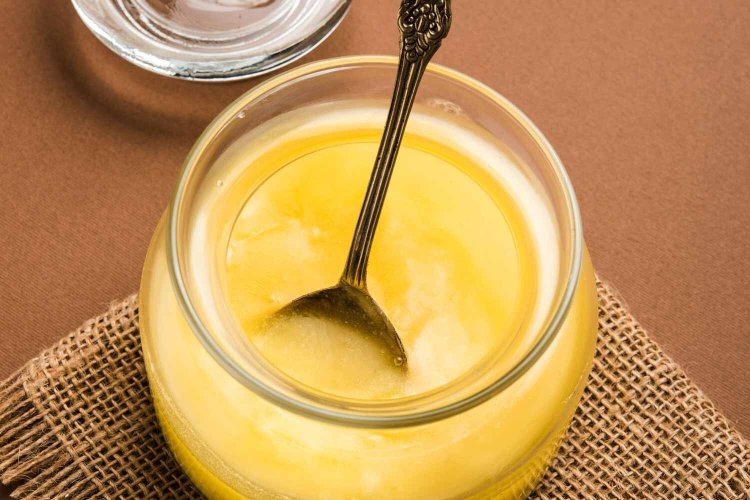Is A2 Bilona Ghee Worth the Hype?
Discover the truth about A2 Bilona Gir Cow Ghee. Learn about its benefits, how it’s made naturally, and if it’s worth the price. Ayurvedic tips inside!

In recent years, A2 Bilona Gir Cow Ghee has taken the health and wellness world by storm. From social media influencers to Ayurvedic practitioners, everyone seems to be raving about its benefits.
But with so much buzz, it’s natural to wonder: Is this golden elixir really worth the hype? Let’s dive into what makes A2 Bilona Ghee unique, how it’s made, and whether it lives up to its reputation.
What Makes A2 Bilona Ghee Different?
First, let’s decode the terms:
-
A2 Milk: This comes from indigenous cow breeds like the Gir cow, which produce milk containing only A2 beta-casein protein. Many believe A2 milk is easier to digest compared to the A1 protein found in milk from hybrid cows.
-
Bilona Method: This traditional process involves fermenting curd from A2 milk, churning it by hand (or wooden churner) to extract butter, and then simmering the butter on low heat to create ghee.
-
Gir Cow: The Gir cow, native to India, is revered for its A2 milk and is central to producing authentic A2 Bilona Ghee.
Unlike commercial ghee, which is often made using cream or machinery, the Bilona method is labour-intensive and time-consuming. Advocates argue that this ancient technique preserves nutrients and enhances flavour, making the final product superior.
The Health Claims: Fact or Fiction?
Proponents of A2 Bilona Gir Cow Ghee highlight several potential benefits:
-
Digestive Health: A2 milk is said to be gentler on the stomach, and the Bilona process retains lactic acid cultures from fermented curd, which may aid digestion.
-
Rich in Nutrients: The slow-cooking process preserves fat-soluble vitamins (A, D, E, K) and antioxidants like CLA (Conjugated Linoleic Acid), linked to anti-inflammatory properties.
-
Ayurvedic Benefits: In Ayurveda, Gir cow ghee is celebrated for balancing doshas, boosting immunity, and improving mental clarity.
But does science back these claims? While studies on A2 milk suggest it may reduce digestive discomfort in some people, research specifically on Bilona-made ghee is limited. Most evidence remains anecdotal or rooted in traditional practices. That said, the absence of additives and the purity of the process do make it a cleaner option than mass-produced ghee.
The Taste Test: Flavor Matters
One undeniable advantage of A2 Bilona Ghee is its taste. The slow fermentation and churning process gives it a rich, nutty aroma and a granular texture that melts effortlessly. Many users swear by its superior flavour compared to regular ghee, which can taste bland or overly processed. If you’re a food enthusiast, this alone might justify the premium price tag.
The Price vs. Value Debate
Here’s the catch: Authentic A2 Bilona Gir Cow Ghee isn’t cheap. A small jar can cost 3–5 times more than regular ghee. The reasons are understandable:
-
Ethical Sourcing: Gir cows are pasture-raised and fed organic fodder, increasing production costs.
-
Labour-Intensive Process: The Bilona method requires skilled labour and time (up to 2 days to make a batch).
-
Low Yield: It takes about 25–30 liters of A2 milk to produce 1 kilogram of ghee.
But is the higher cost justified? If you prioritize purity, traditional methods, and supporting small-scale farmers, yes. However, if you’re on a budget, regular ghee (preferably organic) might suffice for everyday use.
Potential Drawbacks to Consider
-
Availability: Authentic A2 Bilona Ghee is still niche and may be hard to find outside speciality stores or trusted online sellers.
-
Overhyped Claims: While nutritious, it’s not a “miracle food.” A balanced diet and lifestyle matter more than any single superfood.
-
Allergies: If you’re lactose intolerant, consult a doctor before adding ghee to your diet, even though Bilona ghee has minimal lactose.
How to Spot Authentic A2 Bilona Gir Cow Ghee
With rising demand, counterfeit products are flooding the market. Here’s how to ensure you’re buying the real deal:
-
Check for certifications (e.g., FSSAI, organic).
-
The label should mention “A2 milk from Gir cows” and “traditional Bilona method.”
-
Authentic ghee solidifies at room temperature and has a grainy texture.
-
Buy from reputed brands or local farmers with transparent practices.
So, Is It Worth Trying?
The answer depends on your priorities:
-
Yes, if you value traditional food practices, want to avoid processed products, or are curious about Ayurvedic nutrition.
-
No, if you’re looking for a quick health fix or aren’t ready to invest in a premium product.
Think of A2 Bilona Gir Cow Ghee as a luxury ingredient rather than a daily staple. Use it sparingly - drizzle over dal, add to warm milk, or apply on chapatis - to savour its benefits without breaking the bank.
Final Verdict
A2 Bilona Ghee isn’t just a trend; it’s a return to ancestral food wisdom. While some claims may be exaggerated, its purity, nutrient profile, and artisanal production make it stand out in a world of mass-produced foods. If you’re passionate about clean eating or want to explore Ayurveda, give it a try. For others, it’s okay to stick with what works for your body and budget.
After all, no single food can replace a holistic approach to health - but A2 Bilona Gir Cow Ghee might just add a delicious, nourishing touch to your journey.
Also Read: Cold Pressed Groundnut Oil vs. Regular Oil: What’s the Difference
What's Your Reaction?
















